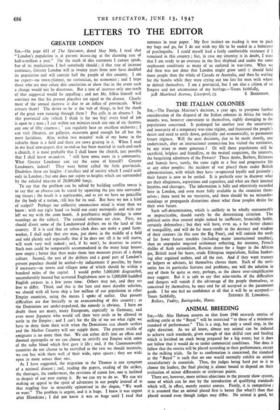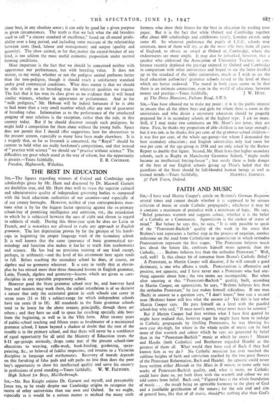ANIMAL BREEDING
Sns,—Mr. Alec Hobson assures us that from 1948 onwards entries of milking cattle at the " Royal " will be restricted " to those of a minimum standard of performance." This is a step, but only a small step, in the right direction. As we all know, almost any animal can be induced to achieve such standards, given enough of that skilful care and feeding which is lavished on stock being prepared for a big event; but it does not follow that it would do so under commercial conditions. Nor does it follow that the entries will be placed according to their performance, except in the milking trials. So far as confirmation is concerned, the standard at the " Royal" is such that no one would normally exhibit an animal unsatisfactory in essentials. Thus, the judges being hard put to it to choose the leaders, the final placing is almost bound to depend on their evaluation of minor differences or irrelevant points.
There are, however, more serious objections to the present show system, none of which can be met by the introduction of qualifying standards which will, in effect, merely restrict entries. Firstly, it is competitive ; it is assumed that an animal placed first is better (for what?) than that placed second even though judges may differ. No animal is good, let
alone best, in any absolute sense ; it can only be good for a given purpose in given circumstances. The truth is that we lack what the old breeders used to call "a sincere standard of excellence," based on all-round profit- ability over a long period, and including some measure of the relation-ship between costs (food, labour and management) and output- (quality and quantity). The show animal, or for that matter the record-breaker of any kind, is too seldom the most useful economic proposition under normal farming conditions.
Most important is the fact that we should be concerned neither with appearance nor performance, but with breeding value. It does not matter, to my mind, whether or not the pedigree animal performs better than the non-pedigree, though it should reach a satisfactory standard under good commercial conditions. What does matter is that we should be able to rely on its breeding true for whatever qualities we require. The fact that it has won its class gives us no evidence that it will breed similar winners, whether in appearance or performance. And as for "milk pedigrees," Mr. Hobson will be indeed fortunate if he is able to find more than a very small number which offer any sort of guarantee of breeding value. Information as to the performance of the unselected progeny of near relatives is the exception, rather than the rule, in this country today. But if he should discover enough such pedigrees, he might hold a competition for them alone without the young bulls. Space does not permit that I should offer suggestions here for alternatives to the present system, especially as many have been made elsewhere. It is a tragedy that, so far as livestock is concerned, the " Royal" should be content to hold what are really herdsmen's competitions, and that instead of " practice with science " we should see " practiceWithout science." The difficulties are great which stand in the way of reform, but the opportunity



































 Previous page
Previous page